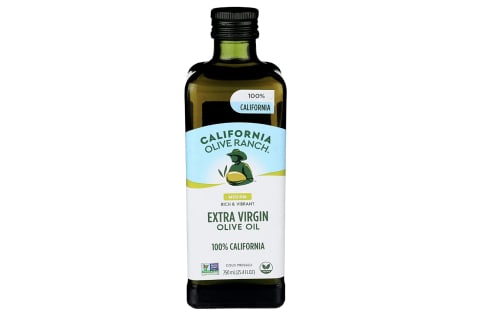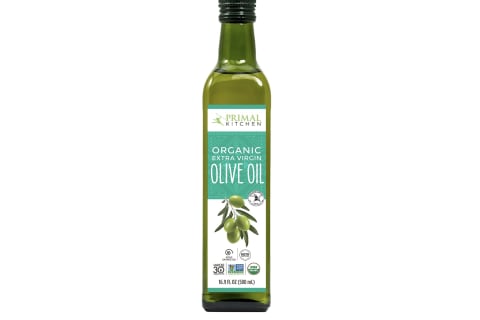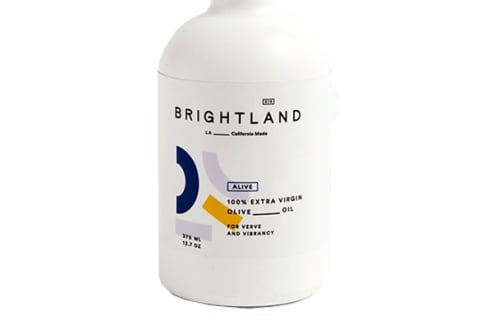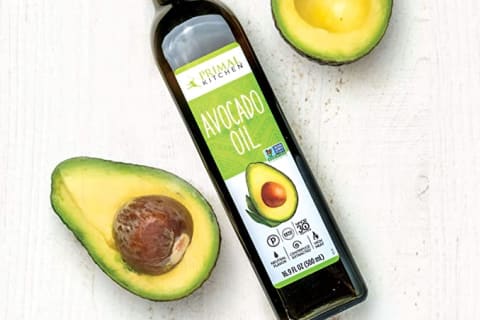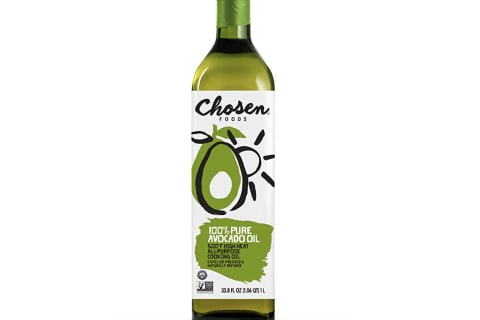Olive Oil vs. Avocado Oil: A Breakdown Of Each + Which Is Healthier


Olive oil has long been considered the healthiest cooking fat for its antioxidant and disease-fighting benefits, especially within the Mediterranean diet. A bit more recently, another healthy cooking fat has made its way to people's kitchens: avocado oil. Both have benefits and nutritional value, so when browsing the oil aisle, which one should you buy?
Here's your guide to the similarities and differences between avocado oil and olive oil, and how to choose between the two healthy cooking oils.
What is olive oil?
Olive oil is a plant-based cooking oil made from the fruit of the olive tree. Once olives are collected, they're pressed into a paste and mixed with water. After mixing, the paste undergoes another pressing and separation process, to remove pulp from the oil.
This final step is where manufacturers might refine, bleach, or deodorize the oil, making it more processed. The healthiest oils are unrefined and minimally processed, though.
"Extra-virgin olive oil (EVOO) is the least processed and therefore has the greatest nutritional benefit, compared to other types of olive oils," registered dietitian Titilayo Ayanwola, MPH, R.D., L.D., previously told mbg. "Since it is derived from olive berries, it contains large amounts of antioxidants, phytosterols, and vitamins1." Those can be stripped away when oil is refined.
Health benefits:
There are many notable health benefits of olive oil. "It is rich in vitamin E, a fat-soluble antioxidant that helps to maintain the integrity of cell membranes and protect it from damage by harmful free radicals," Ayanwola says.
Studies have also linked the monounsaturated fats in extra-virgin olive oil to cholesterol reduction2, making it a heart-healthy oil. It also has benefits for mental health and stress reduction, according to research3, thanks to its high polyphenol content. Plus, it's oh-so-moisturizing for the skin and hair.
Here's a more comprehensive nutritional breakdown of 1 tablespoon of olive oil4, according to the U.S. Department of Agriculture (USDA):
- Calories: 119
- Monounsaturated fat: 9.85 g
- Polyunsaturated fat: 1.42 g
- Saturated fat: 1.86 g
- Total fat: 13.5 g
- Vitamin E: 1.94 mg
- Vitamin K: 8.13 µg
Shopping tips:
On average, olive oil can range anywhere from $10 to $30 per bottle (depending on the quality and the size). Extra virgin olive oil is even more nutrient-rich than standard olive oil. To make sure you're getting the best olive oil possible, follow this trick from olive oil sommelier Katerina Mountanos:
- Pour olive oil into a small round glass.
- Hold the glass with one hand, cover the top with your other hand, then twist the glass in your hand to warm the oil inside.
- Remove your hand and smell the olive oil. "If it smells fresh like grass, fruit, or vegetables, it's more likely that your oil is truly extra virgin. Common identifiable scents from truly premium olive oil are grass, green or red tomato, banana, arugula, spinach, apple, citrus, or almond. If you're not getting much of a fresh scent, it's likely not extra virgin. Anything that smells musty, rancid, or is odorless is not extra-virgin oil," Mountanos says.
- Taste the oil. "A true extra virgin will reveal lots of fruit and vegetable flavors as you swirl it around your mouth and will have a peppery or bitter taste at the back of your throat when you swallow it," she says. Coughing is the telltale sign that it's high quality.
See here for the 10 best olive oils of the year, which all meet these certifications.
Shop olive oil
What is avocado oil?
The process of making unrefined avocado oil is similar to that of olive oil, but the skin and the seed of the nutrient-packed avocado are removed first. "After this, the flesh is ground to a paste and then malaxed for 40 to 60 minutes at 45 to 50°C," according to a statement from the American Oil Chemist Society. (Note: Malaxing just means mixing the paste). "This is a higher malaxing temperature than used for olive oil extraction, but it is still considered to be cold-pressed extraction for avocado oil," they add.
After it's mixed, the paste will undergo a filtration process, like olive oil, to separate the pulp. The final result: what you see on the shelves.
Health benefits:
Avocado oil is also very healthy. "Similar to olive oil, avocado oil is high in monounsaturated fats and low in saturated fat," registered dietitian Mascha Davis, R.D., MPH, previously told mbg. It's also high in antioxidants and carotenoids, which help to lower inflammation and support eye health5, respectively. Like olive oil, avocado oil can also be nourishing for the skin and hair thanks to its fatty acids6.
Here's a more comprehensive nutritional breakdown of 1 tablespoon of avocado oil7, according to the USDA:
- Calories: 124
- Monounsaturated fat: 9.88 g
- Polyunsaturated fat: 1.89 g
- Saturated fat: 1.62 g
- Total fat: 14 g
- Vitamin E: 0 mg
- Vitamin K: 0 µg
Shopping tips:
When buying an extra-virgin avocado oil, there may be more to pay attention to than just "extra-virgin" and "unrefined" labels. A recent Food Control study found most avocado oils in the U.S. market are stale or impure8. In other words, it has either lost its flavor before hitting the shelves, or it was mixed with other types of vegetable oil (think safflower, sunflower, and soybean).
To make sure your avocado oil is high-quality, the researchers recommend looking for these three things:
- Taste: Authentic, fresh, virgin avocado oil should taste grassy, buttery, and similar to mushrooms. A rancid oil will mimic the smell of playdough.
- Color: Virgin avocado oil should be green, compared to a light yellow refined avocado oil.
- Quality: Check the oil's harvest date, which is a better indicator than the "best before" date. Buy smaller bottles to ensure you can finish before the expiration date.
Shop avocado oil
Olive oil vs. avocado oil: Which is healthier?
Despite the similarities in making olive oil and avocado oil, their health benefits and cooking uses vary slightly. Here are the key differences between them:

Olive oil has a higher antioxidant content.
Both avocado oil and olive oil contain free-radical-fighting antioxidants, but olive oil contains more vitamin E—a fat-soluble nutrient that's important for cell signaling and gene expression. It retains its high vitamin E content even when exposed to heat9.
So the winner in terms of antioxidant count? Olive oil, but just slightly.
Avocado has a higher smoke point.
Regardless of an oil's nutritional value at baseline, its benefits are compromised when an oil is heated beyond its smoke point. Smoke point is the temperature at which an oil burns and begins to release pro-inflammatory free radicals.
Avocado oil has a slightly higher smoke point (480°F for unrefined, 520°F for refined) than olive oil (350°F for extra-virgin olive oil, 390°F for light olive oil). This makes avocado oil better for high-heat cooking techniques like pan frying.
Olive oil is slightly higher in oleic acid, a healthy fatty acid.
Both olive oil and avocado oil are both high in healthy monounsaturated fats10 (MUFAs) and low in polyunsaturated fats (PUFAs). This is a good fatty acid breakdown, since PUFAs tend to be less stable and more prone to degradation. The primary MUFA in both avocado oil and avocado oil is oleic acid, but olive oil is slightly higher in this anti-inflammatory fatty acid.
Summary
The best ways to use them.
Because of the smoke point, avocado oil is better for high-heat cooking methods like baking, roasting, searing, and grilling. Save your olive oil for drizzling on salads or pasta dishes, using in short sautés, or simply dipping bread into. Be sure to store your avocado and olive oils in a cool, dark place (not right next to the stove) so they don't go bad as quickly. Here are a few recipes that showcase them:
The takeaway.
Both olive oil and avocado oil contain similar levels of healthy versus unhealthy fats, but when it comes to their anti-inflammatory, antioxidant levels, olive oil may be slightly better for you. Just make sure you're buying the cold-pressed, unrefined, extra-virgin kind. And if you're cooking anything at higher than 390 degrees, opt for avocado oil instead.
If you're looking to expand your oil rotation beyond these two mainstays, here's a master list of the healthiest options for cooking, plus a few to avoid or use sparingly.

Abby Moore is an editorial operations manager at mindbodygreen. She earned a B.A. in Journalism from The University of Texas at Austin and has previously written for Tribeza magazine. She has covered topics ranging from regenerative agriculture to celebrity entrepreneurship. Moore worked on the copywriting and marketing team at Siete Family Foods before moving to New York.
10 Sources
- https://www.ncbi.nlm.nih.gov/pmc/articles/PMC5877547/
- https://pubmed.ncbi.nlm.nih.gov/2649645/
- https://pubmed.ncbi.nlm.nih.gov/23670794/
- https://fdc.nal.usda.gov/fdc-app.html#/food-details/171413/nutrients
- https://pubmed.ncbi.nlm.nih.gov/15735074/
- https://www.ncbi.nlm.nih.gov/pmc/articles/PMC5796020/
- https://fdc.nal.usda.gov/fdc-app.html#/food-details/173573/nutrients
- https://www.sciencedirect.com/science/article/pii/S0956713520302449?via=ihubhttps://www.mindbodygreen.com/articles/avocado-oil-study
- https://pubmed.ncbi.nlm.nih.gov/26434313/
- https://www.ncbi.nlm.nih.gov/pmc/articles/PMC7795523/
